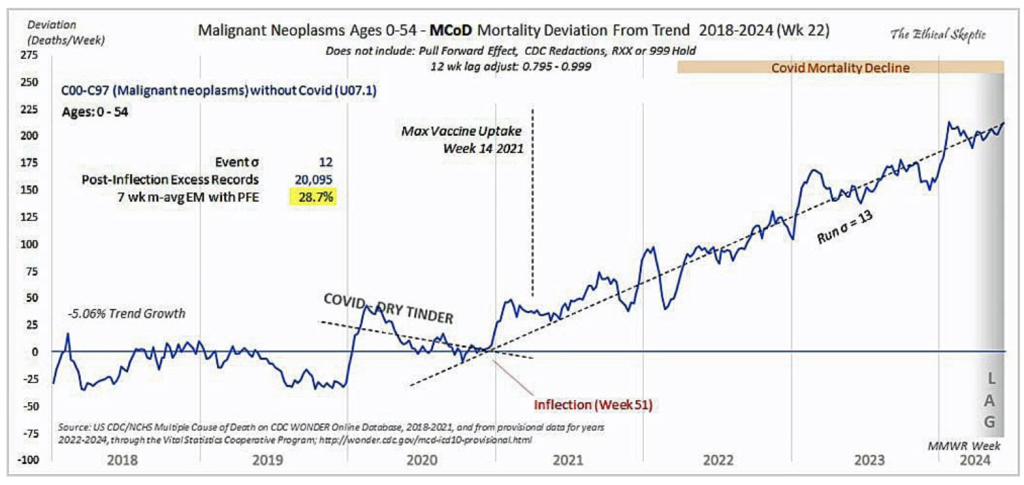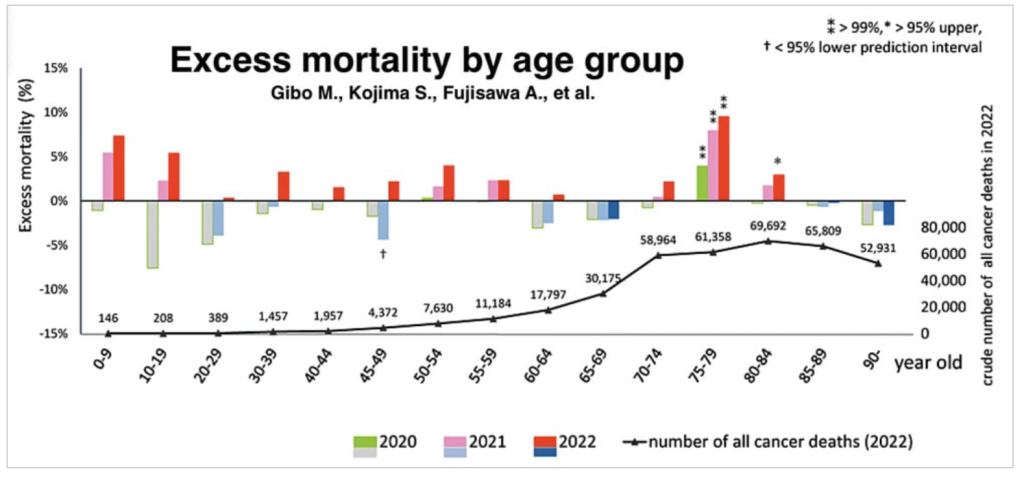
Please Follow us on Gab, Minds, Telegram, Rumble, Gettr, Truth Social, Twitter
Cancer rates among younger generations are rising at an alarming pace, with medical professionals reporting unprecedented increases in aggressive cancers over the past few years.
A study published in the August edition of The Lancet Public Health revealed that through 2019, the incidence rates for 17 of 34 cancer types were increasing in progressively younger people in the U.S., ABC News reported on July 31.
Lead author Ahmedin Jemal, DVM, Ph.D., from the American Cancer Society (ACS) told The Washington Post that if current trends in cancer and mortality rates among Gen X and millennials continue, it “may halt or even reverse the progress that we have made in reducing cancer mortality over the past several decades.”
More recent data from the ACS’ “Cancer statistics, 2024” report — with data on cancer incidence through 2020 and mortality through 2021 — showed the trend continuing.
As of 2021, among adults under 50, colorectal cancer has become the leading cause of cancer death in men and the second-leading cause in women, despite ranking fourth for both sexes in the late 1990s.
Some researchers point to lifestyle, poverty and environmental factors as potential causes for the uptick in cancers, while others suggest the COVID-19 mRNA vaccines may be to blame for the rise in “turbo cancers.”
Meanwhile, Pfizer in December 2023 spent $43 billion for Seagan, a “cancer care” biotech company with only $2.2 billion in sales. Seagan’s already-approved drugs include those for bladder cancer, cervical cancer, breast cancer and Hodgkin lymphoma.
The acquisition expands Pfizer’s oncology portfolio to 25 approved drugs, which, by the second quarter of this year, helped the company recover from last year’s drop in COVID-19 vaccine sales when its stock lost half its value.
The cancer trend has also caught the attention of health organizations worldwide, including the World Health Organization, which in February predicted a 77% rise in new cancer cases — from 20 million cases in 2022 to over 35 million cases by 2050.
Which cancers are on the rise?
The Lancet study revealed disturbing trends in cancer rates for people born between 1920 and 1990, finding that through 2019, incidence rates for 17 of 34 cancer types analyzed were increasing in progressively younger birth cohorts.
For some cancers, the incidence rate was approximately 1 to 3 times higher in the 1990 birth cohort (people in their late 20s at the time of the study) compared to the 1955 birth cohort (people in their mid-60s at the time of the study).
Particularly concerning were the increases in cancers of the small intestine (256% higher), kidney and renal pelvis (192% higher), and pancreas in both males and females (161% higher). For women, liver and intrahepatic bile duct cancer rates also saw a significant uptick (105% higher).
In younger cohorts, cancer incidence also increased for estrogen receptor-positive breast cancer, uterine corpus (endometrial) cancer, colorectal cancer, non-cardia gastric (stomach) cancer, gallbladder and other biliary cancer, ovarian cancer, and testicular cancer, anal cancer and Kaposi sarcoma in males.
For those around 30 years old, cancer rates increased an average of 12% across all cancer types.
The study also noted that mortality rates mirrored incidence trends for several cancers, including liver cancer in females, uterine corpus, gallbladder and other biliary, testicular and colorectal cancers. This suggests that the increase in incidence is substantial enough to outweigh improvements in cancer survival rates.
The findings from the ACS’ cancer statistics report, which contains data through 2021, provide additional context to the rising cancer rates in younger generations, particularly for colorectal cancer in both sexes and breast, cervical, uterine and liver cancers in women.
The Ethical Skeptic, a well-regarded statistician on the social platform X, posted more recent cancer mortality data. The following graph, based on the Centers for Disease Control and Prevention’s WONDER online databases, shows excess mortality from malignant neoplasms (spreading tumors) “elevated 29% and still rising” for ages 0-54 through week 22 of 2024:

More recent ‘turbo cancers’
Dr. William Makis, a Canadian board-certified nuclear medicine radiologist and oncologist, reported in an interview on the “America Out Loud PULSE” podcast on July 6 that he has seen “just an explosion of extremely aggressive cancers in very young individuals” since the COVID-19 pandemic began.
Cancers Makis identified that are particularly affecting younger populations include breast cancer, colon cancer, bile duct cancer, pancreatic cancer, leukemia and lymphoma.
Makis emphasized that these cancers are presenting at advanced stages (3 or 4), are behaving “very aggressively” and are often resistant to conventional treatments. He referred to these as “turbo cancers” due to their rapid growth and spread.
Dr. Angus Dalgleish, a renowned oncologist and professor at St. George’s, University of London, has reported rapidly progressing cancers in patients receiving COVID-19 mRNA booster shots, although he did not specify the ages affected.
In particular, melanoma patients who had been in remission in his practice experienced sudden relapses. Cancer doctors around the world told him him about rapidly accelerating cancers, including lymphomas, leukemia, kidney and colorectal cancer and “multiple metastatic spread” of cancers throughout the body.
A Japanese study published in April in the journal Cureus reported post-COVID-19-vaccination increases in mortality for most age groups, including those under 50 years old. Cancers with the highest excess mortality rates included ovarian cancer, leukemia, prostate cancer, lip/oral/pharyngeal cancer and pancreatic cancer.

We do not have the data to point to’
Mainstream medical experts have proposed several theories to explain the rising cancer rates among younger generations.
In the Lancet paper, the authors attribute the increase in cancers in younger people to higher exposure to carcinogens early in life, obesity, unhealthy diet, environmental chemicals, changes in reproductive patterns and alcohol-related behaviors.
In its “Cancer statistics, 2024” report, the ACS pointed to several additional potential culprits, including poverty-related factors such as inadequate health insurance and lack of access to screening and high-quality healthcare, and to structural racism-related factors, including mortgage lending bias and neighborhood-level redlining.
Dr. William Dahut, a medical oncologist and ACS chief scientific officer, told ABC News that finding a single cause is difficult. “It’s so easy for us to say ‘yes, it’s obesity’; ‘yes, it’s lack of exercise’; ‘yes, it’s processed food.’ But we do not have the data to point to.”
Dr. Kevin Nead, a radiation oncologist and assistant professor in the Department of Epidemiology at the MD Anderson Cancer Center, told ABC News that something different could be happening with the biology of cancer in younger patients, indicating a need for new approaches to screening and early detection.
Left entirely unaddressed by the current mainstream medical and media reporting is the potential contribution to the rising rates of brain, thyroid and salivary gland cancers of EMR (electromagnetic radiation) exposure from cellphones, Bluetooth headsets, Wi-Fi routers and 4G/5G transmission towers.
Rapid cancer onset ‘basically impossible along the known paradigm’
Dr. Harvey Risch, professor emeritus of epidemiology at the Yale School of Public Health, told The Defender, “Clinicians have been seeing very strange things, for example, 25-year-olds with colon cancer who don’t have family histories of the disease.”
He stressed that this cancer typically takes decades to develop and that its appearance in younger people is “basically impossible along the known paradigm for how colon cancer works.”
On the podcast with Makis, Dr. Peter McCullough, a prominent cardiologist and researcher, also noted the typically longer lead time for cancers to develop.
“Is what we’re seeing now — are these just individuals who have cancers at the time they take the COVID vaccines or are these brand new cancers caused by the vaccines?” he asked.
Possible mechanisms for mRNA vaccine-caused cancers
Makis hypothesized that the mRNA vaccines could be accelerating already existing cancers and are likely responsible for the recent rise in aggressive cancers.
“These lipid nanoparticles [LNPs] — one of the key features is that they don’t stay in the arm. They end up in the systemic circulation,” Makis said.
He suggested that about 75% of the injection ends up in the bloodstream within a few hours, potentially depositing “pseudouridine, modified mRNA and DNA” throughout the body. He listed the brain, bone marrow, liver, pancreas, gall bladder, spleen, testes, ovaries, liver, colon and breast milk as among the locations where these components have been found.
“We are seeing cancers where there is deposition of these vaccine particles,” he said, noting that bone marrow deposition could be causing the increased incidence of leukemia.
Risch, while cautioning that long-term data is still lacking, pointed out potential mechanisms by which vaccines might affect cancer risk.
“The spike protein is toxic,” he stated. “The LNP itself is toxic. The biological manufacturing process involving inadequate filtration of possible harmful components can be toxic.”
Both Makis and Risch discussed the “IgG4 [immunoglobin type 4] antibody shift” caused by the mRNA vaccines as a likely contributor to rapid-onset cancers.
Risch explained how this particular antibody differs from IgG1 and IgG2 responses, which work to neutralize foreign pathogens. By contrast, IgG4 creates a “tolerance response” to keep the immune system from overreacting to things like pollen and food allergens.
Makis explained how after multiple mRNA injections, the level of IgG4 antibodies markedly increases, reducing immune surveillance, thus making “cancer invisible to your immune system.”
“If you’ve got tolerance to cancer cells, it’s not going to stop the cancer cells from reproducing,” Risch said. “You don’t want that to happen.”
Risch said that no one yet knows the depth of damage to the immune surveillance mechanisms the mRNA vaccines are causing, “but there are plausible mechanisms to be looking at.”
John-Michael Dumais is a news editor for The Defender. He has been a writer and community organizer on a variety of issues, including the death penalty, war, health freedom and all things related to the COVID-19 pandemic.
“© [2024] Children’s Health Defense, Inc. This work is reproduced and distributed with the permission of Children’s Health Defense, Inc. Want to learn more from Children’s Health Defense? Sign up for free news and updates from Robert F. Kennedy, Jr. and the Children’s Health Defense. Your donation will help to support us in our efforts.
